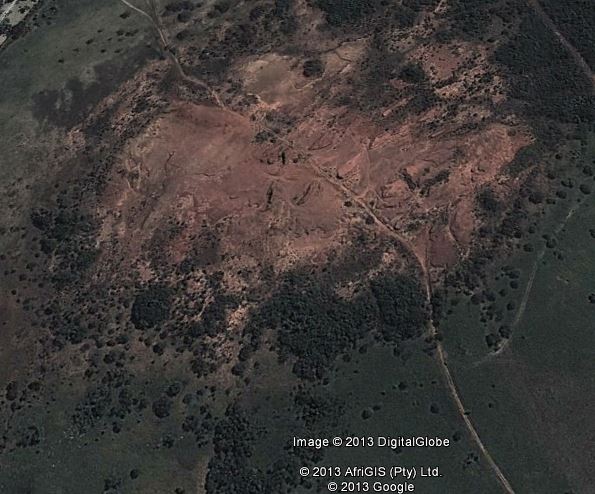This peculiar phenomenon is surrounded by myth and legend including stories that this is the site of an alien landing and overgrazing of the land by a Zulu tribe in the 1800’s, with vast cattle herds stolen from the Pondo’s. The terrain became severely over grazed and subsequently eroded by wind leading to the desertification.

Geology
I contacted Professor R Uken from the UKZN Geology department, and he explained the”desert” as follows:
“It is a small remnant of Berea Red Sand that lies directly on a very flat surface of Msikaba Formation sandstone. This coastal plateau extends all along the coast, especially marked from Port Edward to Waterfall Bluff, and represents an erosion surface that dates back to before the breakup of Gondwana.
As the proto Indian Ocean opened, the first marine sediments of Cretaceous age were deposited on this surface. These sediments are preserved in a few places along the coast and contain marine fossils (Trafalgar Beach etc). They are generally soft and semi-consolidated because they were never deeply buried. After Gondwana breakup the coast experienced renewed uplift and erosion. The cretaceous sediments were easily eroded away exposing the old pre-Cretaceous Msikaba surface again. It was on this surface that dunes fields were generated probably as far back as the Miocene with a basal boulder bed representing beach deposits overlain by dune sand. Sea level has gone up and down with the ice ages and dunes are also found submerged on the continental shelf and were formed when sea levels were low during glaciations (during this time the northern hemisphere was covered in an ice sheet lowering sea level- only the Drakensberg may have a small ice sheet on top of it).
The dunes mainly consisted - like today, of quartz sand but also shell fragments and heavy minerals such as ilmenite and magnetite. These are Fe-Ti oxide minerals. These minerals were weathered in the dunes by oxidising groundwater releasing iron in the form of iron hydroxide. This stained the sand the rusty Berea Red colour. Shell fragments released calcium carbonated in places cementing the dunes to form a rock called aeolianite. The coastal dunes have been greatly reduced in size by weathering and erosion and the red desert is one such remnant.”

Sources and acknowledgements:
Prof R. Uken, Geology Department, University of KwaZulu-Natal
http://targetstudy.com/nature/habitats/deserts/
Please note: This is a very sensitive dune area, and one isn’t allowed to walk all over it. Please remain on the footpath leading from the parking area co-ordinates to the published co-ordinates. All questions can be answered from the published co-ordinates.
Educational logging tasks.
1. Look at the surrounding area at the published co-ordinates, and describe the desert in terms of colour, texture, and formation.
2. In the description above, you will find a classification of deserts. In your opinion, considering the local climatic factors, is this a true desert? Qualify your answers.
3. At reference point 1, you will find a structure. What is that type of rock called? Estimate the height?
4. Unfortunately, man’s presence has caused some ecological damage to the surrounding ecological sensitive area. Look carefully at reference point 2, as well as from the published coordinates and list all the damages that are clearly noticeable.
5. Alien plant invaders are also disturbing the sensitive desert ecology. What is the predominant alien plant invader in the area?
Please do NOT detail your answers in your Found log. Email answers directly to me via the GC.com website.
You may submit your Found log without waiting for confirmation. If there is a problem with your answer(s) I will get back to you. Found logs will be deleted if an email is not received within 2 days.